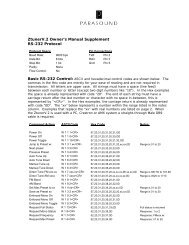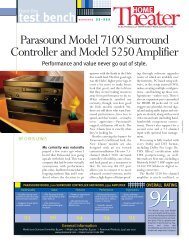You also want an ePaper? Increase the reach of your titles
YUMPU automatically turns print PDFs into web optimized ePapers that Google loves.
6<br />
REAR PANEL CONNECTIONS AND CONTROLS<br />
Connection Precautions<br />
Disconnect the AC cord before and while making or changing any input, trigger, or speaker<br />
connections. Make sure there is no strain or tension on any connections that could cause<br />
them to pull loose.<br />
Antenna Connections<br />
The <strong>Ztuner</strong> <strong>v.2</strong> cannot receive any FM or AM stations without separate antennas for each band.<br />
Adequate reception and sound quality depend on antennas suitable for your location.<br />
FM Indoor Wire Antenna<br />
A standard FM “folded dipole” T-shaped flexible wire antenna<br />
is included with your <strong>Ztuner</strong> <strong>v.2</strong>. It should be adequate for most<br />
urban and suburban locations where there aren’t surrounding tall<br />
buildings and/or hills.<br />
Attaches to<br />
Antenna Wires<br />
Attach to <strong>Ztuner</strong> 75 Ω<br />
Antenna terminal<br />
Connect the 300 Ω (ohms) antenna wire’s two spade connectors to<br />
the screw terminals on the small 300 Ω to 75 Ω balun adapter. First loosen each screw and insert<br />
a spade lug under each of the lock washers. Tighten the screws to hold the wires securely.<br />
Push the balun’s plug carefully onto the round antenna receptacle marked FM 75 Ω.<br />
You should be prepared to adjust the position of the wire antenna to optimize reception. Clear<br />
reception of certain stations may require a different antenna orientation, especially if there are<br />
tall buildings and/or hills nearby.<br />
Outdoor Antenna<br />
For best reception with the least background noise, we vrecommend the use of a high-quality<br />
outdoor FM antenna. Use round 75 Ω coaxial cable from the antenna with an “F” connector (not<br />
included) which you plug into the <strong>Ztuner</strong> <strong>v.2</strong>’s 75 Ω FM antenna receptacle. If you use flat 300 Ω<br />
twin lead antenna wire, use the balun adapter as described above.<br />
Cable Transmission<br />
Most cable companies transmit FM stations as well as TV. Check with your local cable company<br />
about the availability of FM stations. The quality of FM radio varies widely among cable operators.<br />
Your <strong>Ztuner</strong> <strong>v.2</strong> connects the same way as a second television: Use a TV-FM signal splitter (not<br />
included) with the incoming cable connection and connect one wire from the output of the splitter<br />
to connect your television and the wire from the other output to the <strong>Ztuner</strong> <strong>v.2</strong> FM connector.<br />
Powered FM Antennas<br />
A small powered indoor antenna is sometimes useful when it’s impractical to install an outdoor<br />
roof-top antenna or where FM transmission is not available via cable or a community TV/FM<br />
antenna. However, powered antennas can occasionally add noise and distortion. In many cases,<br />
you will receive clearer signals with the supplied dipole wire antenna.<br />
AM Antenna<br />
Connect the two wires from the loop antenna to the Antenna terminals marked AM and GND.<br />
Position the antenna for best AM reception.<br />
Audio Out Jacks<br />
Connect standard audio cables from the stereo L and R Output jacks to the Tuner input on your<br />
preamplifier or system controller. You may connect the <strong>Ztuner</strong> <strong>v.2</strong> to any line-level input, even if<br />
the input isn’t labeled “tuner.” There is also a 1/8” (3.5 mm) mini jack for stereo connections.<br />
The jack tip is L, the ring is R and the sleeve is ground.<br />
There is an additional Mono output jack which is useful for zones where only mono speakers are<br />
installed (such as hallways, small rooms). The <strong>Ztuner</strong> <strong>v.2</strong> outputs stereo and mono simultaneously.




